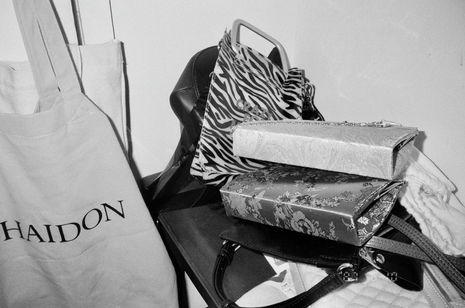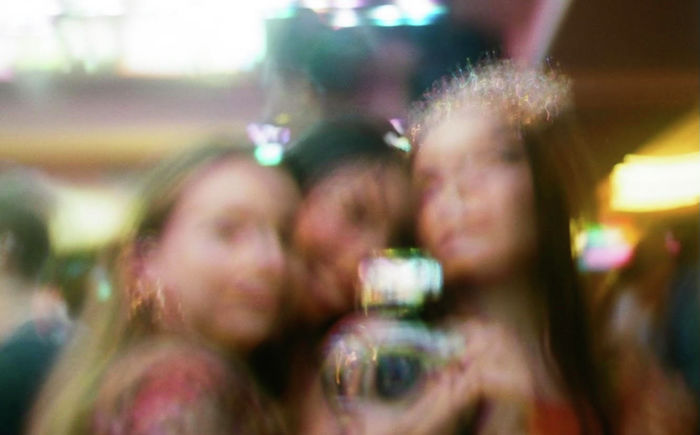Packing it all up and leaving
Fashion Editor Anna Chan meditates on the importance of clothing when displaced from home, via two runway collections

“What would be the first thing you would want to take with you when you know your neighbourhood would be raided?” is a question a young Hussein Chalayan asked his mother about the period of intercommunal violence in Cyprus in the 1960s.
Old photographs, a blanket, and her favourite clothes was her answer.
Chalayan turned this into a performance for his Fall 2000 show. Four models take the covers from chairs in the show’s living room set and unfold them, slipping them on and folding them into dresses. The final model then enters, and removes the central circular panel of the coffee table the chairs are arranged around. She steps inside, and lifts the table. It unfurls into an A-line wooden skirt.
Being ‘part of the furniture’, as a figure of speech, means that someone or something is so familiar and unwaveringly permanent that they become essentially invisible. To be furniture is to be static, an always-present part of the background.
“When we leave home behind, how can we take pieces of it with us?”
Chalayan flips this on its head. Can we take our homes with us? Is furniture really that permanent? When we leave home behind, how can we take pieces of it with us? Furniture becomes clothing, transforming from a coffee table to a skirt that sways and moves with the body. Home is not ‘part of the furniture’: it can be brought with us, but this impermanence also makes it vulnerable to loss and destruction.
Demna Gvasalia’s show for Balenciaga Fall 2022 also comes to mind. Held in March this year, conflict in Ukraine escalated as the industry continued to flounce around the major fashion cities with gowns and champagne. The Balenciaga show offered no such escapism, instead soaking its audience in the discomfort of reality. “The war in Ukraine has triggered the pain of a past trauma I have carried in me since 1993, when the same thing happened in my home country and I became a forever refugee,” Gvasalia wrote in the show notes.
In a round theatre, models trudged in monochromatic looks that flapped in increasingly strong winds as the audience watched, unharmed, through the glass. Some models were carrying bin bags, others wrapped up in towels and in boxer shorts. Backstage, Gvasalia noted that the pieces this season were more packable and easy to throw on, having no buttons or zippers.
“They are objects that sometimes let us down, flapping in the wind in its soaked languish”
Clothing is recast, restored to its most basic function as a second skin that protects us from the physical world. They are objects that sometimes let us down, flapping in the wind in its soaked languish, that we fold and stuff into our suitcases or that we wear to help weather literal storms.
Gvasalia’s Balenciaga pendulates between satire and tone-deafness. His comments on modern commercialism and playing into the absurdity of the luxury industry seem like hellish self-aware shallowness coming from a company who makes over €2 billion, probably spent thousands building this snowy catwalk and who also sells clothes at thousands of pounds.
But there is sincerity behind it. Gvasalia is interrogating the role fashion can play in the face of disasters and anxieties: “I was thinking for a while, “What are we doing here, with fashion? Should I cancel?” But no: I decided we must resist.” He related the show’s simulative scenario to his feelings of helplessness fleeing war in Abkhazia, Georgia in 1993, and arguably it is here more than ever where Gvasalia finds that clothing fulfils its most elemental purpose. It’s not a luxury.
Leaving home, we take our clothes and pack it all up. It comes with us, on our backs and folded into suitcases. Adam and Eve left the Garden of Eden with nothing but their leaf lingerie. We often only think about how clothes look. But these are physical artefacts that carry weight and take up space, that we unfurl to put over our bodies and that travel with us. And when we leave home, they are perhaps more important than ever.
 Comment / Plastic pubs: the problem with Cambridge alehouses 5 January 2026
Comment / Plastic pubs: the problem with Cambridge alehouses 5 January 2026 News / Cambridge businesses concerned infrastructure delays will hurt growth5 January 2026
News / Cambridge businesses concerned infrastructure delays will hurt growth5 January 2026 News / New movement ‘Cambridge is Chopped’ launched to fight against hate crime7 January 2026
News / New movement ‘Cambridge is Chopped’ launched to fight against hate crime7 January 2026 News / Uni-linked firms rank among Cambridgeshire’s largest7 January 2026
News / Uni-linked firms rank among Cambridgeshire’s largest7 January 2026 News / AstraZeneca sues for £32 million over faulty construction at Cambridge Campus31 December 2025
News / AstraZeneca sues for £32 million over faulty construction at Cambridge Campus31 December 2025









